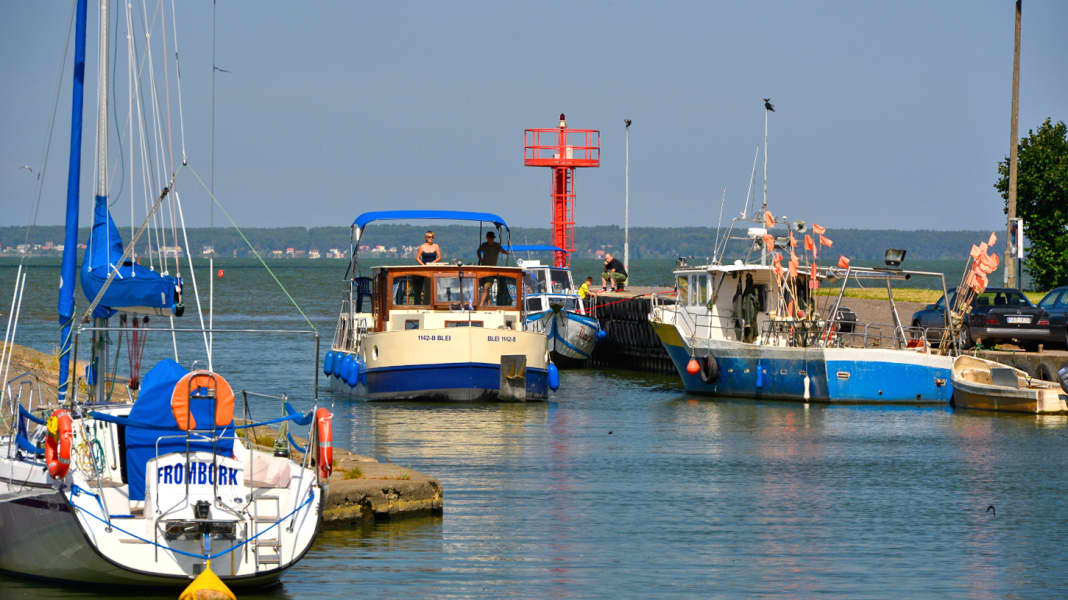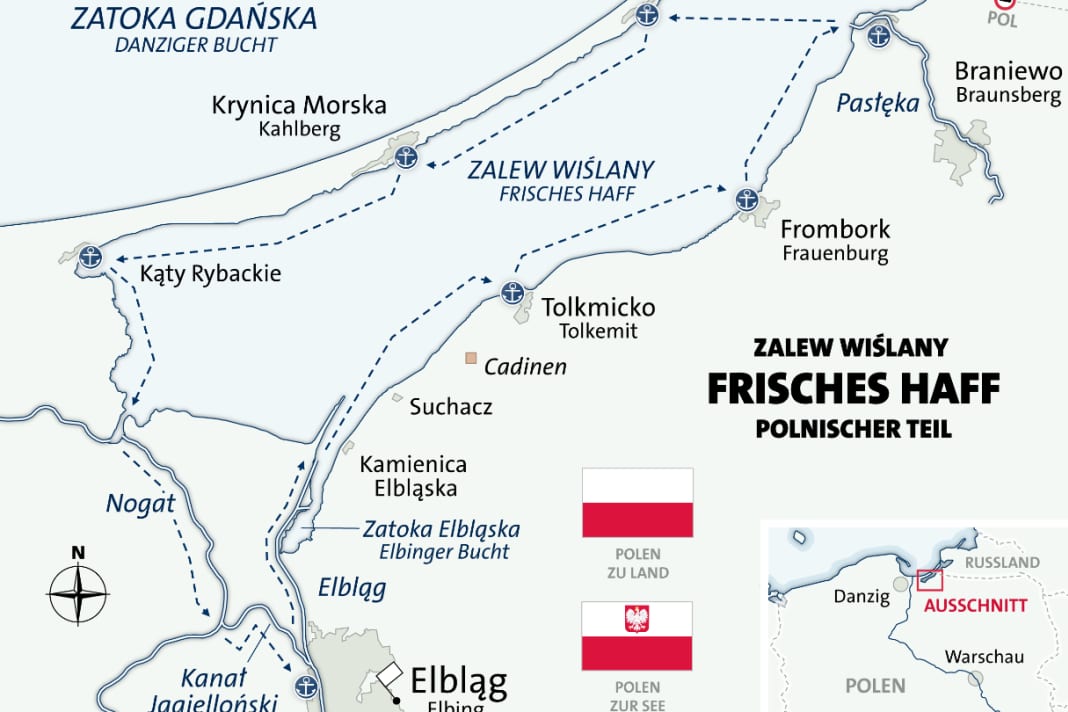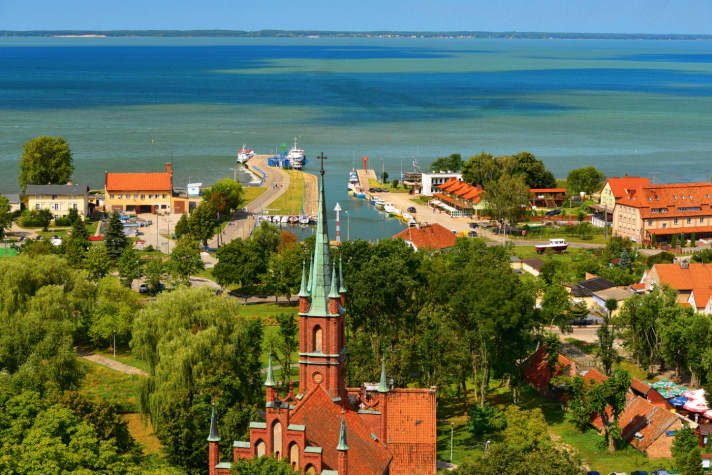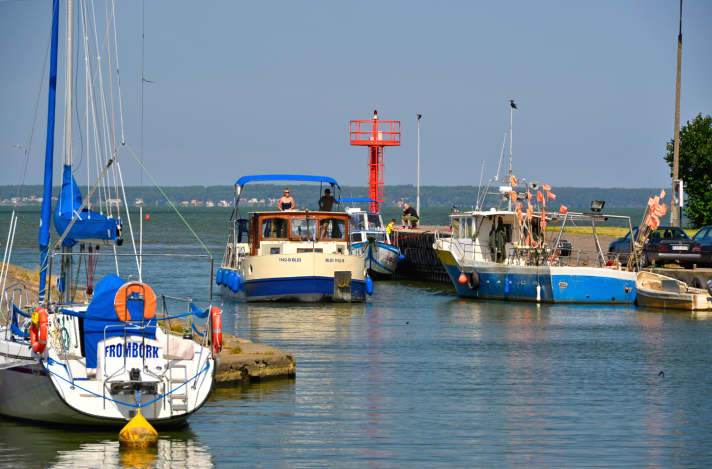







The midday sun burns hot as we steer the houseboat northwards on Elbing Bay. A dyke flanks the western shore, behind it is marshland with meadows, fields and drainage ditches. The brick tower of the Nikolaikirche church in Elbląg, formerly Elbing, towers aft. Ahead, the horizon can only be guessed at. Ahead, the summer air shimmers. Away from the shipping lane, the water is shallow and overgrown with reeds and water lilies, dotted with white specks: swans. The landscape is so beautiful that you have to look twice.

From Elbląg out onto the lagoon
I can't help but think of the old song about the "five wild swans", which has its roots here in former East Prussia. The National Socialists deleted it from the German song repertoire because of its pacifist content. After that, the East German cultural comrades tried to erase any memory of East Prussia and the Memelland. But the "wild swans" survived all wars and dictatorships.
A red lighthouse appears on the starboard side. The horizon opens up and the Bay of Elbląg flows into the Vistula Lagoon, Zalew Wiślany on the Polish maps. A nor'easter has combed streaks of foam across the water and a short wave crashes against the bow of our "Kormoran" from Kuhnle-Tours.
We took over the charter boat in Elbląg. We are the first guests who want to explore the Vistula Lagoon, a long-forgotten water sports area, from this new base. To be correct: Our destination is its western, Polish part. The eastern part belongs to Russia. The border is about 15 nautical miles away. On the green line ahead, we can now recognise the Vistula Spit, the narrow, sandy strip of land that separates the lagoon from the open Baltic Sea. There are only a few sailing boats on the way, creating a peaceful picture.
Big promises in the travel guide
We leaf through the freshly printed "Travel Guide for Water Tourists" and look for the next harbour on the south coast of the lagoon. We discover the entrance to Kamienica Elbląska, the former stone village. I remember the small fishing harbour from a visit about 25 years ago. Back then, there was a jetty for fishing boats, an old water pump and a railway station with a connection to Elbląg.
Now the travel guide promises a marina with electricity, water, a faeces extraction system and waste oil disposal. And next door there is supposed to be a supermarket, a gas bottle exchange station and sanitary facilities. Sounds good!
We steer into the 400 metre long tube of the harbour. At the entrance we get stuck in the mud for a moment. Never mind, there's a modern marina coming up, isn't there? The tubular harbour ends in front of the old railway station. The tracks are rusty, the jetty has long since collapsed. Apart from that: nothing.
The next attempt in Suchacz
While skipper Siegrun is turning, I read that the reconstruction was subsidised by the European Regional Development Fund. I have no doubt that the euros were sent from Brussels to Steinort. But what does the Swan Song say? "No one has been seen again."
Succase, now Suchacz, is the next harbour. This time there are even more symbols in the aforementioned handbook. There is supposed to be a marina with a harbour master, café and restaurant. Perfect for a snack! We set course.
We head for Succase in the beautiful afternoon sunshine. There are lots of sailors in the harbour whose children are taking part in an Opti regatta. After a narrow entrance, a large basin opens up. Small sailing yachts are moored on the starboard side with their bows facing the shore. There are brand new jetties on the port side and a new clubhouse with a restaurant and sanitary facilities on land. And on a sign, the yacht club thanks the EU for the funding.
A strange greeting
We turn our houseboat in the harbour and head for the large new floating jetty. A man in a T-shirt with the word "Bosman" (Polish for harbour master) comes to us on the jetty. I hand him the front mooring line. He looks at me briefly. Then he turns round and walks away. A young Polish woman watching the situation calls after him. He calls back in Polish. The young woman translates: "Only boats up to six metres long are allowed to moor here".
I reply that all the sailing boats moored here are longer than six metres. And the jetty is at least 15 metres long. The woman calls after the harbour master again. He turns round briefly and says that guests are not welcome.
No luck in Kadyny either
We want to cast off. But the young Polish woman says in perfect German: "Please stay!" She takes our mooring lines while the harbour master watches from afar. "My name is Maria, I'm a sailor and I'm on holiday here. The harbour has been renovated with EU funds. Everything you see here" - she points to the new jetties, sanitary facilities and restaurant - "you helped pay for. I'm ashamed of those who accepted the money and now don't want any guests."
We don't want to cause Maria any problems and cast off again after half an hour. The next harbour is sure to come: Kadyny. The former Cadinen was the country residence of Kaiser Wilhelm II, but the harbour can allegedly only be entered with a draught of up to 0.8 metres. Because we want to see the castle with the Trakehner stud farm, we try it anyway. No chance: the basin is silted up and the old piers are totally dilapidated.
Schnitzel and beer for reconciliation
The wind picks up in the evening, so we should slowly find a place to spend the night. We stay on the south coast and head for Tolkmicko, formerly Tolkemit. The harbour there is well protected by two piers. We enter the harbour at sunset. The piers and a floating dock for small yachts are new, as is the sanitary building. Work is underway on green areas and service columns for electricity and water. There is a new toilet block in the south-west of the harbour. Next to it is the now familiar sign stating that the harbour has been rebuilt with EU funding. Free WiFi zone included. Only the ruins of the fish factory are a reminder of the socialist planned economy.
With growling stomachs, we hurry to the nearby old town and are the last guests to rush into the first restaurant. The landlord makes schnitzel with fried potatoes and coleslaw. It is accompanied by Tyskie beer from one of the oldest breweries in Europe. We pay five euros per head and are completely satisfied. In the morning, we discover a beach next to the harbour with a new, stylishly furnished fish restaurant, also subsidised with EU funds. We take the public bus two kilometres back to Kadyny to see the imperial residence after all.
The estate was given to Wilhelm II by a local district administrator and developed in keeping with his status. The surrounding forests were placed under protection so that hunts could be organised. The Emperor also had the later famous Cadinen majolica workshop founded: The colourful glazed ceramics, also known as Cadinen tiles, still adorn the Old Elbe Tunnel in Hamburg, Berlin underground stations and the magnificent Prussian buildings of that era. The entire site is now a listed building.
Where Copernicus developed his world view
Eight miles east of Tolkemit lies Frombork, the former Frauenburg. Here, at the beginning of the 16th century, the canon and astronomer Nicolaus Copernicus developed the heliocentric view of the world with the sun at the centre and the planets orbiting around it. At the time, this was in direct contradiction to the geocentric world view of the Catholic Church. Nevertheless, Copernicus was not persecuted as a heretic, but was able to devote himself to his celestial observations and mathematical calculations as a financially secure canon.
He was buried in the cathedral in Frauenburg, but exactly where he was buried has been forgotten. However, as many visitors asked about the grave, the search for his remains began in 2004. A year later, a skeleton was found whose skull shape suggested that it could have been the famous astronomer. DNA traces in the teeth, which were comparable to those found in two hairs in the university library in Uppsala, Sweden, brought certainty. The hairs were found in a book that was stolen from Copernicus' library during the Swedish-Polish War. In 2010, the bones were buried in a new coffin. Today, a glass plate in the floor of the cathedral provides a view of Copernicus' grave.
Piotr is a good mooring
Frombork harbour is pretty to look at, although no money from Brussels has been spent here yet. There are no service pillars for electricity and water. Where can we fill our water tank? On the east quay of the harbour we see the new "Smazalnia Portowa", a fish frying kitchen with a guesthouse above it.
Of course I have water," says the owner in perfect German and rolls out a hose. "My name is Piotr and I lived in Bremen for a long time. Today it's worth investing here." We go alongside a fishing trawler to bunker. Next to it is a Bayliner with a Russian flag on the stern. I ask Piotr if many boats cross the border.
"For places close to the border on both sides, there is a small amount of border traffic without visas. Some Russians and Poles cross the border by boat. But since the Ukraine crisis, there are only a few."
As thanks for the water, we go to Piotr's for dinner. He conjures up a platter of fish from the lagoon. Everything tastes fresh and delicious. We pay 24 euros for four people, including drinks.
Our table goes overboard
We set sail from Frauenburg at around 6 pm. Our destination is Neu Passarge, today Nowa Pasłęka, the last town before the Russian border. Piotr wishes us a good journey, points to the sky and says: "There may be a lot of wind. Watch out for the border!"
When we leave the harbour, the wind is blowing at five Beaufort, just as the weather forecast had predicted. We initially sail in the buoyed fairway and then head north-east. Within minutes, the sky closes in. The waves are more than a metre high, but the "Kormoran" puts up a good fight. The only thing I wish for now is a few more horsepower. Suddenly we are hit by such a strong gust that the table on deck lifts off, whirls over the railing and disappears into the water.
Heading for the EU's external border
That's too much and we decide to turn round. We spend half an hour washing the deck with breakers. Finally the harbour approach with the Copernicus Tower of Frombork. As if in mockery, the storm subsides a stone's throw from the harbour approach. A rainbow stretches over the cathedral in the most beautiful evening light! But now it's too late to head back towards Nowa Pasłęka. At least we now know that the weather on the Vistula Lagoon can change within minutes.
We set off again in the morning with a light westerly wind. We first head towards Russia and then turn to starboard about one kilometre before the EU's external border. As we approach and look for the approach, a large RIB with blue lights shoots towards us. To our relief, it bears the inscriptionPolish Border Guard. The border guards ask if we want to go to Russia. "No, to Nowa Pasłęka," we reply, "you mustn't take the buoyed fairway. Drive half a kilometre north of the harbour approach into the Pasłęka River. There are two small red poles and a green one at the narrowest point." He points the way. All we see are reeds.
A modern marina at the end of Poland
Luckily, a fishing boat with the same destination comes by. We cling on. The closer we get to the shore, the clearer the mouth of the Pasłęka becomes. Sandbanks and gill nets protrude into the fairway from both sides. As the officials said, the narrowest point is actually marked with poles. However, those not familiar with the area should only attempt this approach in daylight and in calm weather.
We drive just under two kilometres upstream. On the right, low brick houses duck behind the dyke. Fishing boats have pulled ashore in the reeds and storks stalk across damp meadows. East Prussia straight out of a picture book. After a bend in the road, the view opens up. Completely unexpectedly, a modern boat harbour appears here at the end of Poland with a newly paved shore area, electricity and water columns, a slipway and a modern sanitary building. We find a berth alongside the new quay in front of the bridge.
The only marina in the world without boats
Originally, we wanted to travel eight kilometres up the Pasłęka River to the district town of Braniewo, formerly Braunsberg. However, the closed bridge is too low for our boat and the folding technology has been broken for decades. We take a taxi to Braunsberg to buy a new deck table at the DIY store. Our driver says with a grin: "Braunsberg is the only town in the world that can afford a marina without boats." He drives to the centre, where a wooden bridge spans the river.
Next to it is a brand-new marina reception building the size of a detached house with reception, toilets, showers, launderette, self-service kitchen and barbecue area on the terrace. From there, two wide staircases lead to a top-quality floating dock. Everything is made of solid concrete and galvanised steel. "21 million złoty have been sunk here, 5 million euros," explains the young man. "This jetty has been here for three years and no boat has ever used it. Because of the low bridge. Everyone knew that. It was built anyway."
Scene of a great drama
With a new table for the "Kormoran", we leave the beautiful mooring and head out onto the lagoon again. Our course leads westwards to the Curonian Spit. It's hard to imagine that the worst refugee dramas of the Second World War took place here on the lagoon 70 years ago: Until January 1945, the German population in Königsberg and northern East Prussia had been held down with slogans of perseverance. On 10 February, the Red Army captured Elbing, cutting off the land route to the west for over two million civilians. Hundreds of thousands attempted to flee across the ice of the Vistula Lagoon to the spit on horse-drawn carts or on foot - an easy target for Soviet fighter planes, which bombarded the refugees with cannons and destroyed the ice with explosive bombs.
Towards evening we reach the fishing village of Nowa Karczma, which used to be called Neukrug. The centre pier has already been renovated, but is fully occupied. We find a berth between fishing trawlers on the north pier. On land, there are fish trap poles and mountains of nets. Everything is quaint and rustic. There are a few simple pubs and bars along the main road. A forest path takes you to the Baltic Sea beach in a quarter of an hour's walk, with surf unlike anything we know from the western Baltic Sea.
Life is raging in Krynica Morska
We motor westwards along the Curonian Spit and reach the modern-day seaside resort of Krynica Morska, formerly Kahlberg. The people here were obviously wide awake when Brussels opened its purse strings: the entire harbour and landside areas were renovated. And we don't want to talk about trivialities such as hundreds of bollards and stainless steel park benches. What is probably unique is that no fenders are needed in Krynica Morska: Over a length of 750 metres, all quay walls are fitted with permanently mounted pads made of hard rubber, namely a vertical fender strip every 40 centimetres. According to the harbour master, they cost around 1000 złoty each, including installation, or around 240 euros. This means that the fendering of the harbour basin alone cost around 450,000 euros. I am happy to pay the 32 złoty (6.61 euros) harbour fee in the hope that I will soon help to amortise the EU expenditure.
Life is buzzing in Krynica Morska. Next to the harbour is an amusement park with a rollercoaster, disco, bars and restaurants. Here, too, you can walk across the spit to the sea in a quarter of an hour. On the Baltic Sea beach, snack stalls and bars ensure that you won't get bored at sunset.
Where the circle closes
We continue westwards to Katy Rybackie, the former Bodenwinkel, where we find a berth in the fishing harbour. The town is still modest compared to neighbouring Krynica Morska. The only restaurant is a fish frying kitchen at the harbour. Everything is simple, rustic, cheap - and yet delicious.
There are about a dozen guest spaces available. You can see from the west pier that the funding has been put to good use here too: The new service building with reception, toilets and showers is already finished. In the neighbouring small basin for local boats, each six-metre boat has its own box with its own power column - even with a connection for 380-volt three-phase current.
In the south-west of the Vistula Lagoon, we head into the delta of the River Nogat. Here they are again, the wild swans. We travel twelve kilometres upstream and then turn east into the Jagielloņski Canal, which connects the Nogat and Elbing rivers. Our circle around the Vistula Lagoon has come full circle.
SERVICE INFORMATION
Company, boat, prices
Kuhnle-Tours is one of the largest providers of houseboats in Europe, with bases in Germany, France, the Netherlands and Poland. With the start of the 2014 season, three more charter areas in the north-east of the country have been added: The Vistula Lagoon, the Oberland Canal and the Vistula Lagoon. The new charter base for all three areas is the yacht club in Elbląg (Elbing).
Charter boat: The "Kormoran 1140" rented by us is one of the classics of the Kuhnle fleet. The boat has a spacious cabin fore and aft, each with a double and a single bed. Each cabin has its own bathroom with shower/WC. A large galley with fridge and gas cooker as well as a spacious saloon offer ample space for up to six people.
There is an outside and an inside steering position with bow thruster and depth sounder. I missed a compass on the open waters of the Vistula Lagoon, as well as nautical equipment at the chart table. A GPS with plotter would also be a useful addition to the equipment. However, according to the charter company, all houseboats sailing on the Vistula Lagoon will be equipped with GPS from 2015.
Although the tried and tested boats in the "Kormoran" series are robust and can withstand a capful of wind, in our experience you should still leave the Vistula Lagoon and seek a safe harbour if the wind exceeds five Beaufort.
Technical data: Length: 11.40 m, beam: 3.90 m, draught: 0.75 m. Engine: Nanni diesel 45.6 kW (62 hp), fuel consumption approx. 6-7 l/h. Diesel tank 530 litres, water 1000 litres, waste water 1400 litres. Kuhnle-Tours rents out the houseboats without a licence. However, the lagoon may only be navigated up to 4 Bft, otherwise up to a maximum of 6 Bft.
Prices: The "Kormoran 1140" costs between 1582 and 2926 euros from Elbing, depending on the season. Deposit: 1200 euros; 9.60 euros are charged per operating hour for fuel, lubricants and gas.
Contact: Kuhnle-Tours,Hafendorf Müritz,17248 Rechlin (Müritz),phone: 03 98 23-26 60. www.kuhnle-tours.de
Journey
The Hungarian budget airline "W!ZZ" flies non-stop from Lübeck, Dortmund, Cologne, Frankfurt/M to Gdansk. We paid 190 euros per person (return journey). www.wizzair.com
The journey from Gdansk Airport to Elbing is 74 kilometres and takes just over an hour. Transfer in a VW bus (up to 7 people) via the company Taxi-Van costs approx. 85 euros. Mobile +48-602-21 71 11, e-mail: e.gierszewski@chello.pl. www.autotaxivan.pl

